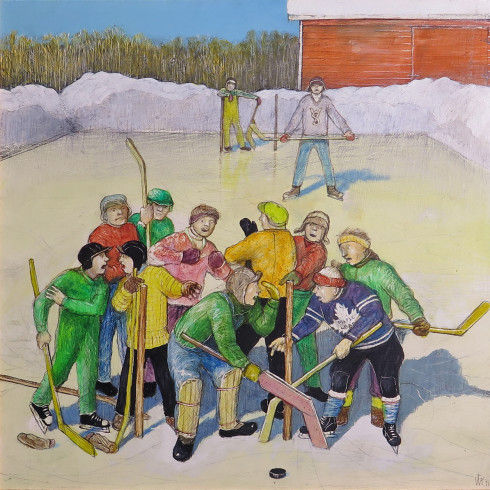Serge Lemoyne
 "At one and the same time the instigator of “happenings”, social agitator and activist, artist of electronic, visual and sonic media and, above all, an indefatigable painter, Serge Lemoyne was probably the most audacious of Québec’s postmodern artists."
Galerie Simon Blais
"At one and the same time the instigator of “happenings”, social agitator and activist, artist of electronic, visual and sonic media and, above all, an indefatigable painter, Serge Lemoyne was probably the most audacious of Québec’s postmodern artists."
Galerie Simon Blais
Serge Lemoyne was born in Acton Vale, Québec on June 13, 1941. He was perhaps the first Québécois pop artist. Lemoyne was a member of the avant-garde and a pioneer of performance art in Québec in the 1960s. He is best known for improvisations such as La Semaine A (1964), or his "happenings," which incorporated the use of his splash technique of tossing paint onto the artwork support. Serge Lemoyne preferred popular subjects for his paintings, as in his celebrated "red, white and blue" period in which he employed colours based on the Montreal Canadiens uniform.
Lemoyne studied at the École des beaux-arts de Montréal from 1958 to 1960. While a student, he was greatly influenced by two groups of Québécois artists. One, known as Les Automatistes, a group whose method of making art was one in which the artist suppresses conscious control over the art making process, allowing the unconscious mind to have great sway, and the other, the Plasticiens, a Canadian non-figurative painting movement, which appeared around 1955 in Québec.
Lemoyne had a collaborative approach to making art, seeking active engagement between artwork, audience and the artist. He helped found L'Horloge du Nouvel-Age in 1964 with Claude Péloquin, Yves Hébert and Jean Gauguet-Larouche. A year later he also formed Le Zirmate. Both groups held events combining music, poetry, dance and visual effects to create "happenings"-a performance, event or situation that could be considered art.
His work was greatly inspired by pop culture-he devoted ten years to exploring hockey. His tribute to the Montreal Canadiens, Bleu, blanc, rouge (1978), is created in the team's colours. Blue, white and red are also the colours of the flags of France and the United Kingdom-the two colonizing countries of North America. Lemoyne's best-known work, Dryden (1975), an abstract portrait of the Montreal Canadiens star goaltender Ken Dryden, is also part of this colour period and can be found in the collection of the Musée des beaux-arts de Montréal.
In 2008, ten years after his death, the Musée des beaux-arts de Sherbrooke organized Salut Lemoyne! an exhibition of work by Lemoyne exhibited together with the works of other Quebec artists with whom he was associated. This included Armand Vaillancourt, Pierre Gauvreau, Janine Carreau, Hélène Goulet, Reynald Connolly, Cozic, François Gauthier, Gilles Boisvert and Serge Tousignant.
Art contemporain en fin de siècle (1994), produced by Jacques Larré, profiled Lemoyne, as well as the photographer Geneviève Cadieux and artist and architect Melvin Chaney. Lemoyne: documentaire sur la vie et l'oeuvre du peintre Serge Lemoyne (2005) examines Lemoyne's approach to creating art through personal videos, television archives and interviews with his peers, Claude Péloquin, Marcel Saint-Pierre and Claude Jasmin.
Serge Lemoyne died of cancer on July 12, 1998. He was 57-years-old.





